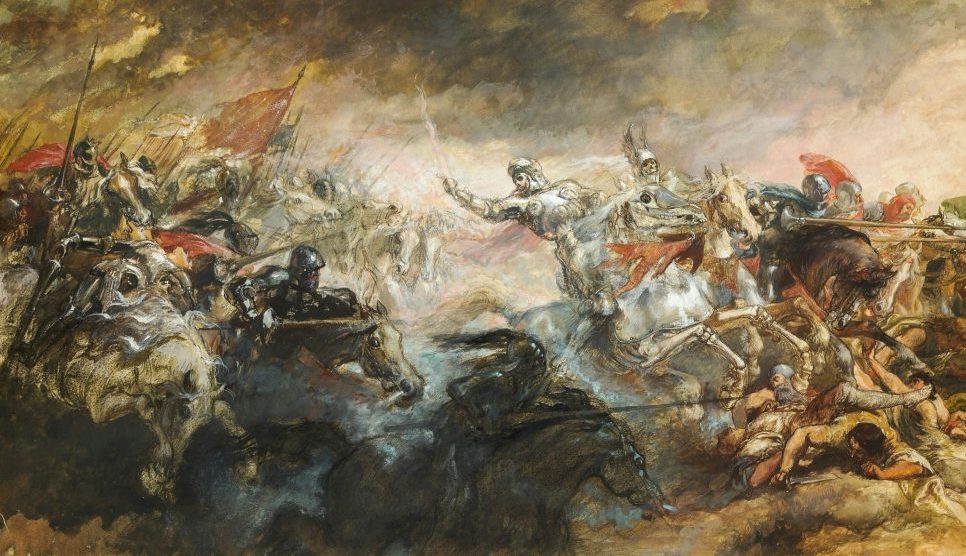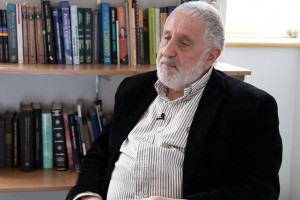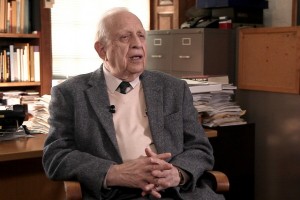DNA Topology
Molecular biologist Maxim D. Frank-Kamenetskii on the round form of DNA, changes in topology caused by topoiso...

One way to answer how scientific knowledge grows and evolves is the military history of ideas. The answers available in sociology today are not very effective. There’s an old philosophical idea attributed to Karl Popper: the notion that scientific ideas exist in an independent realm, in a third world, directly connected to the objects they describe. However, humans are only indirectly related to this third world, as the absolute spirit doesn’t care whose mind it enters. In this sense, ideas are entirely autonomous from the subjects who produce and use them.
Another model, sociologistic, which was very popular in sociology in the 1970s-1980s, suggests that ideas are imprints of certain collective interests and representations of the world. Thus, science continues the social processes it is part of.
The third way of dealing with ideas, proposed by the Cambridge School of Intellectual History, involves several assumptions that are not very pleasant for sociologists: it argues that ideas are not autonomous but are intertwined with the objects they describe. The main question and problem here is the question of the agency of ideas: to what extent and in what sense do ideas have the ability to act independently of those who use them, enter into alliances with them, and in what sense can we say that an idea itself is an agent of scientific production.
Let’s start with some examples. In 2015, a case was heard in the British Court of Appeal: an appeal by a large pharmaceutical company against another. The first company patented an antiseptic solution containing 1 to 25% silver. The second company carefully examined the patent and began producing a similar product containing 0.77% silver. The first company sued: “Guys, they stole our recipe.” The second responded: “No because you patented 1%.” The lower court dismissed the claim, which said that 0.77 is not one. The court used a mathematical extrapolation rule: anything greater than 0.95 is one, and anything less than 0.95 is not.
The first company appealed, and the Court of Appeal ruled not favouring the second corporation, Convatec. It determined that one should be considered any number from 0.5 to 1.5. Lord Justice Christopher Clarke, explaining his decision, said: “Perhaps for a linguist, one is nothing more than one, but in our judicial practice, we must consider that not only words but also numbers are inseparable from the context in which they are used. In our practice, one will be considered anything greater than 0.5 and less than 1.5.” Why does judicial practice oppose itself to linguistic practice?
Let’s move to 1585 when mathematician Simon Stevin published his famous treatise “De Thiende,” where he first started the war for popularising decimal fractions. In this treatise, Stevin proves that one is a number. Today, this seems strange, but for almost 2000 years since Diophantine mathematics, one was not considered a number. Until 1585, as Aristotle wrote in “Metaphysics,” a number is what we mean in everyday language when we say that a certain number of people attended a lecture. “A certain number” means there were more than one. If one person attended my lecture, I would hardly say that a certain number of people attended, although today, we know that one is a number. Until 1585, this knowledge was deeply non-obvious, and Stevin had to act as a good mathematician and politician to prove it. He made some alliances and used rhetorical arguments that seem dubious today. For example, he wrote: “If a number consists of units, then a unit must also be a number. This is like saying that a piece of bread is not bread.” A rather strange logical argument for a mathematician: like saying that if a molecule consists of atoms, then an atom is also a molecule. Nevertheless, Stevin managed to make this radical turn. And thanks to him, today we know that one is a number.
Meanwhile, there is a gap between the fact that one is a number and the discussion of one in the British court. A military historian of ideas tries to understand how the continuity of conceptualizations occurs. To clarify this story, we need to turn not to the history of mathematics but to the history of linguistics.
In 1906-1911, Ferdinand de Saussure, a Swiss linguist who laid the foundations of semiology and structural linguistics while teaching his course on general linguistics, made a basic distinction between language and speech. Language is a system that has its logic, is close to formal systems and is independent of specific actualizations in speech situations. When I talk to you, I use language, but the language at that moment is only actualized in speech, so speech is secondary to language. What de Saussure did is called an intellectual move. He made a basic distinction between language and speech, assigning relevance to language. Then, he made linguistics possible because linguistics is now a self-sufficient science since language is not based on speech but on itself, and speech is secondary to it.
Forty years later, Ludwig Wittgenstein overturns this opposition and says: “Yes, there is language, and there is speech, but speech is primary.” Language is a formal abstraction that exists only in the heads of linguists because in reality, meaning is used. We cannot understand the meaning of a word just by looking it up in the dictionary because the meaning of a word is how it is used in a specific context. This gives rise to the most famous Wittgensteinian turn to practice, where to understand what language is, we need not delve into dictionaries or interview linguists, nor try to study linguistics, but start studying how people talk. This intellectual move by Wittgenstein is amusing because it is inversive. He uses the distinction made by de Saussure but shifts the relevance accent from one side to the other, thereby ensuring a privileged position for discourse pragmatics over semantics.
In the next stage, in the 1960s-1970s, in the city of Edinburgh, sociologists of knowledge, who also study the sociology of mathematics, led by Barry Barnes and David Bloor, say: “An excellent model — there is language, and there is speech. If meaning is used, then the meaning of a mathematical expression is also how it is used.” Mathematics is not a universal formal system. The language of mathematics is an abstraction existing only in mathematicians’ heads. In reality, we need to look at how specific theorems, specific numbers, and specific arguments are used here and now. Wittgenstein’s turn to practice in the philosophy of language is made by the Edinburgh School in the sociology of knowledge — the so-called strong program in the sociology of knowledge applied to mathematics.
Bloor writes how Stevin, using rhetorical moves, proves that one is a number because Stevin is an engineer. Before Stevin, mathematics and arithmetic were the prerogatives of people close to theology, and the main function of a number was classification. In this numerical order, almost according to Pythagoras, a certain divine cosmos manifests itself. But ballistics, engineering, and other fields begin to develop, and engineers make some claims to mathematics. Diophantine mathematics existed then and did not satisfy them, so Stevin’s argument appears.
Note Bloor’s explanation: he uses the model of thinking created by Wittgenstein in his war with de Saussure as a resource. He applies it to the mathematical argument, showing that there is a certain form of life called “engineering,” in this form of life, one is a number. The same argument is used by Lord Justice Christopher Clarke, proving that the court has the right to define one because, in his judicial practice, one is everything that is more than 0.5 and less than 1.5.
The story does not end there. There is a small problem with the Wittgensteinian move. What explanation does the sociologist of knowledge offer? He says that just as in language, meaning is use, the meaning of one is the use of one, so there is some engineering practice, and in it, one is a number. And in another form of life called Lebensform, one is not a number. There is a certain rule, and there is a certain practice. Does this mean that in the self-sufficient form of life called “engineering,” we should not consider any other social factors besides how people use this or that mathematical form or how they use this or that meaning in proving a theorem?
In 1976, Saul Kripke, a philosopher and Wittgensteinian, interpreted the 201st paragraph of Wittgenstein’s Philosophical Investigations, where he said this thesis had a problem. We must admit that a certain linguistic community of people define how correctly or incorrectly to use this or that word in this or that practice. Bloor reluctantly agrees with this, and as a consequence, now we need to talk not about engineering practice as speech practice, where some meaning is acquired by some word. We have to talk about the fact that there is a certain community of engineers with their views of the world, morphology, and structure. And it is communities that determine whether one is a number or not.
Similarly, in 2015, we should have said that there is a certain community of judges with their views of justice, and their views, as well as their procedural structure, determine what will be considered one and what will not. At this moment, the betrayal of the idea occurs when an idea in some development allies with another idea, and you realize that this is a fatal move, but you have no choice: having said A, you must say B. The idea leads you to the abyss, and all that remains for Bloor is to watch in horror as it leads him into the arms of Durkheim — into the arms of the old sociology with which Bloor fought all his life, for the sake of fighting with which he turned to Wittgenstein, because in the old sociology, practice, speech use, meaning, forms of life are not self-sufficient, but are derivatives of the structure of specific social formations. One more step and Bloor will have to say that Simon Stevin’s class interests led to the recognition of one as a number. One more step, and he will come to Durkheim and say that one is a number for reasons of community solidarity and not because one is a number.
It turns out that the movement from Wittgenstein to Durkheim is predetermined by the very argument to which he turns, and as soon as he turns to it, behind his back appears a guard of former allies with knives. These are the Wittgensteinian sociologists who did not follow Saul Kripke towards what he called the sceptical solution. They create a completely different sociology of mathematics without Bloor and those who betrayed Wittgensteinian ideas by turning to the dark side of old Durkheimian sociology, uttering the cursed word “community.” In this new sociology of mathematics, there are no communities. Still, there are some self-sufficient practices of proving theorems, only forms of life, and no social and class structures that could stand behind them. This is how the remarkable works of Michael Lynch and Eric Livingston appear, where there remains some fidelity to the original Wittgensteinian idea of “meaning is use,” but precisely in practice, not because of some class interests.
When we study how ideas act, we no longer ask questions about what class interests stand behind them and what social circumstances led to their emergence. We ask one question: how do they act, and what alliances do they enter? Today, the researcher’s task is to show how material objects, social subjects, and ideas that stand between them form various heterogeneous alliances.

Molecular biologist Maxim D. Frank-Kamenetskii on the round form of DNA, changes in topology caused by topoiso...

On biological collections, biobanks, and stakeholder interests

Nobel Prize laureate Roy Glauber on avoiding predetonation, the Trinity test, and the hydrogen bomb